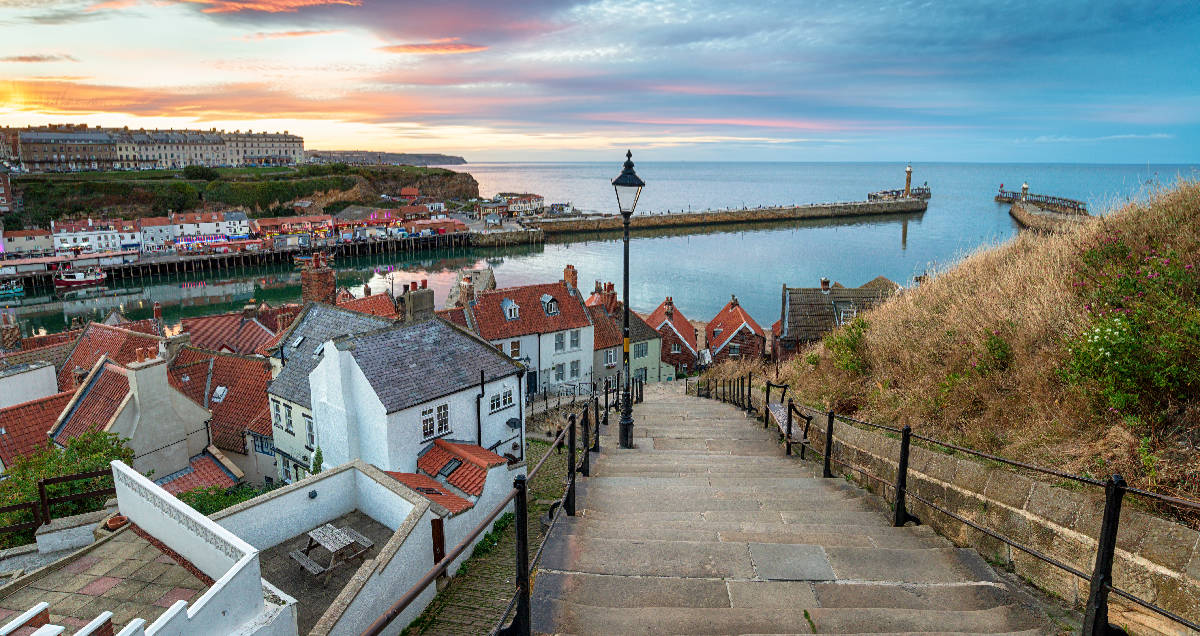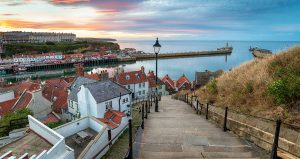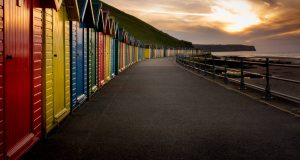
Welcome to Dracula Country!

Image: Radek Sturgolewski/Shutterstock.com
Bit of a dramatic headline for a seaside town like Whitby? Well if you have read Bram Stoker’s classic you will understand! Why – well Whitby Abbey is a key location in it. But hey not everyone reads 19th Century novels, so here is our quick guide to this lovely North Yorkshire coastal town which is the ideal location for a bit of a staycation, especially if you like a bit of gothic horror.
Ok if your ready let’s begin with a bit of history…
Early Whitby Days
The origins of Whitby go all the way back to pre-history, but the name itself can be traced to the Brigantes. These were one of the ancient tribes that dominated the British Isles in the days before the Romans, the Normans, or anyone else came along.
The Brigantes named the town Sinus Fari, which reportedly changed to Streanaeshaic in medieval times. By the time the Romans had retreated, Whitby Abbey had been established here. It is said to date from 657ad when King Oswy ordered a monastery built to celebrate his victory over the Pagan king of Mercia, which made him ruler of Northumbria… back in the days before England united into one country. He was buried here around 13 years later so at least got some use out of it.
This monastery was one of the few that could be attended by men and women alike. It was the site of a Saint, in its first Abbess, but was destroyed by the Vikings when they started raiding along the coast around the turn of the 9th century when successive raids over three years made it a lost cause. It is one of the sites frequently attacked by the famous Ubba and Ingwar duo. The town and monastery remained in ruins until William the Conqueror showed up in the 11th century.
Whitby In The Doomsday Book
In the Domesday survey carried out in 1086 when the aforementioned conquering king wanted to survey his new winnings, Whitby was Small even by North Yorkshire standards of the time and overall in the smallest 30% of settlements. It comprised 4 households and was owned by Earl Hugh of Chester. It contained a mill, woodland, and meadows, as well as ploughlands. Legend has it that William the conqueror gifted it to William de Percy as a thank you for all his hard work invading, but that a few years later the second Willy donated it to some monks. They set up a Benedictine monastery, which attracted more people to the town and ended up with someone building a port for it, too. The town grew steadily until the 12th century when it was given a charter to hold a fair once a year.
The Early Modern Age Whitby
By the 15th century, there were houses, a port, a town, a church, a monastery, and all manner of attractions springing up to attract the local nobility. Whitby was a market town, and it was thriving. Despite its popularity and success, the town was still subjected to the closure of the monasteries authorised by Henry VIII when he wanted his 45th divorce. The monastery was dissolved but it had done its job. Whitby was a growing town that was spurred to further success a few hundred years later with the onset of the Industrial Revolution.
Georgian Whitby
Every port in Britain suddenly became incredibly valuable at the start of the Industrial Era. At the start of the 16th century, they had a population of roughly 250 people, still being a slow-growing market town. From 1635 right up until 1835, the burgesses of the land were in charge of tithes charged in the small fishing port… but alum was found three miles from town and was mined from then on into the Industrial era. It is a sort of silvery rock, often used in Victorian era medications, and even in beauty products.
The port at Whitby grew as more and more alum was quarried and exported. Oak and timber were shipped here two, and a second pier was eventually added as the town grew. In 1790, they recorded more than 11k tonnes of shipped goods, making them the third-largest in Britain. Taxes were raised by port tithes, allowing the town to expand even more. In 1753 the first whaler set sail, and in 1814 8 ships caught 172 whales from this port… not a happy record, although it would have been at the time.
Whaling Was Big
Whaling was huge in that pre-Victorian era. The blubber was used as fats and perfumes, the bones for corsets, and oil would be extracted to the tune of 230 tons. Whitby had a whale oil firm that turned into a gas and coal firm when whaling declined. Throughout the 17th and 18th centuries, Whitby acted as an important trading post between Newcastle and London. Coal was traded here by the masses, fuelling the Revolution of Industry.
During the Georgian years, Sea Bathing became popular as the belief grew that it was good for the health. tourists flocked to the sea in areas just like Whitby, and the area received a boost from tourism. Restaurants, gardens, and in 1839 a railway, were all built to accommodate this. The railway brought more people, and the town grew from there.
The Industrial Revolution in Whitby
The last wooden ship left Whitby port in 1871 as the rise in the Iron Ship took hold. Jet was found in the cliffs and moors around the town and was prized as a jewel. Locals would make extra income by shining beads of jet and selling them to passing strangers. When Queen Victoria came to power, she popularised the black stone by going through several years of mourning for her husband.
Whitby became a bustling port during the Industrial era, but quickly declined as the demand for jet and iron shipping waned. The town’s population was well on its way to the 13k people that live there today – but was still favoured as a holiday destination over a place to live.
While Whitby thrived under the weight of the coal and industrial processes throughout the rest of Yorkshire, acting as a backdrop to sustain the steady tourist flow to the region.
Bram Stoker
Bram Stoker is said to have stayed in the Royal Hotel in Whitby circa 1890, leading him to use several locations in his novels most notably the famed Whitby steps (all 199 of them) at the top of which is a church and graveyard which as the opening picture shows would make the perfect setting for any gothic horror story. His most famous novel Dracula was published in 1897 and given the town’s prominence in the story it has embraced it into its culture. Today there is a Whitby Dracula Society, a Dracula Trail and even a couple of Goth Weekends which are great fun even if you are not a huge fan of the genre. The now ruined Whitby Abbey is one of the most recognisable landmarks in the story and is well worth a visit.
The War Years
The next remarkable circumstances for the seaside town came in WWI.
The First World War saw a hospital ship hit the rocks and capsize just off the bay, 229 souls went under, of which 85 didn’t make it to shore. Some of them are buried in empty coffins in the churchyard in remembrance. During the same war, German ships situated off the coast of England managed to kill up to 200 souls in and around the region, so Whitby was one of the few towns that actually was bombed during WWI – just not by planes.
In WWII, a German plane crash-landed near Whitby, having been shot down while attacking a trawler off the coast (well food was in short supply which is the only justification we can think of for declaring war on a fishing boat). The Town was largely spared the ravages of the bombing but lost a significant number of its men to the war effort.
Post War Whitby
In more recent years, a 1955 worker’s strike at the docks in Hull led to an improvement in conditions and safety measures there. This resulted in a number of ships being diverted and dumping cargoes in the fish quay of Whitby. In 1964 the local council opened a railway station at the wharf, doubling the capacity for outsiders to visit the seaside for the day.
A heritage railway was built in the early 20th century, only to be closed again in the 60s. Locals revived it a few years later and, to this day, it is a volunteer-run organisation. Also in the early 20th century, the last of the large jet deposits were excavated to exhaustion.
In the 1970s, Whitby imported paper, timber, and chemicals from all over Europe to help build England. In 79 they dredged out a marina in the upper harbour. Since 2010 it has been opened for business.
Modern times has seen Whitby a quiet harbour town with a population of around 13 thousand people. Although small in size, it remains grand in stature. The town is a proud place with plenty of coast to relish, that manages to attract tourists every year, steadily. We hope it continues to do so for all the years to come.
Fun Facts About Whitby!
No official Five Minutes Spare tour of any town is complete without us finding the funniest, most interesting, or just the strangest, points of interest. Regarding Whitby, here are some of the things you can quote to people when they ask you what you love best about their town:
- The entire northeast coast was ripe with smugglers. To avoid port taxes on rum, sailors would trade under the cover of darkness, off the coast of England. Whitby was one of the places that harboured those smugglers.
- Between 1750 and 1840 whaling ships headed out of Whitby port to do their dirty work.
- Captain Cook studied here to be a Captain.
- Parts of the town – the 199 steps at the cliff, the church and abbey ruins, were all used as locations in Dracula. Bram Stoker was apparently very inspired by the town.
- Laurie Mitchell-Henry landed the British Rod Caught record Bluefin Tuna on a boat out of nearby Whitby in 1933. The fish weighed 851lb (around 386 kg) and would be worth £ Millions today!
There are thousands of hot tips about Whitby. did you know it is a fossil hunting coast, for example? With so much to do it really does make an excellent choice for a northern staycation.
Famous People from Whitby
Whitby has more than a few famous faces to have emerged from their ranks. It might be a North Yorkshire town and far removed from the bright lights of London – but that doesn’t mean that it doesn’t have its fair share of famous people. Here are some of Five Minutes Spare’s most notable favourites:
- Captain James Cook, Whaler, sailor, and immortalised in legend, was born and learned to sail from Whitby harbour.
- Several sports personalities, including footballer David Mills who made 296 appearances for Middlesborough and cricketer Neil Nicholson who played at County level for Yorkshire.
- Mark Richardson, the drummer for the likes of Skunk Anansi and Feeder, is a Whitby musician.
- Theresa Thomlinson, the children’s and young adult fiction writer, is from Whitby. Her most recent book Wolf Girl is one we can recommend having read it
- Golfer Iain Pyman who played in the 1993 Open Championship and also won several Challenge Tour Trophies was Whitby born.
As you can see from this famous people cross-section – there are plenty of famous folk in town that can testify to how wonderful Whitby is… or at least, how happy they are to be out of it…
Whitby Attractions
What is there to do in Whitby? What sights should you see? Are there any attractions in town you should visit ? We put together the best places and things to see and do in Whitby – all for you!
Historic Sights and Landmarks
There are plenty to choose from but we have settled on these three to get you started…
Whitby Abbey

Image: Emily Marie Wilson/Shutterstock.com
Let’s start with the famous Whitby Abbey. Although partially crumbling, this place has stood since the Vikings wrecked the monastery, all the way back in the early centuries. Go along and see the magnificent architecture, climb the famous stairs, and take some scenic shots of the town and sea. Definitely top of the list of places to visit in Whitby.
While in town, you have to take in Whitby harbour, without a doubt. This place goes all the way back to the times of the old port and the pre-industrial era. Whitby harbour is as old as the sea that surrounds it… so go have a wander among the boats.
Let’s not forget the ruined Whitby Abbey. Although partially crumbling, this place has stood since the Vikings wrecked the monastery, all the way back in the early centuries. Go along and see the magnificent architecture, climb the famous stairs, and take some scenic shots of the town and sea. Definitely top of the list of places to visit in Whitby.
St Mary’s Church and churchyard is mentioned and described in Dracula, by Bram Stoker, and so is a historic sight that has been preserved down throughout the ages. Whether you are a religious person or whether you are a literary buff, this is a sight to add to the list.
Outdoors and Recreational
If you love the great outdoors then Whitby has plenty to offer be it walking the Dracula Trail, going Whale watching or trying to catch your own tea down on the beach you are sure to find something appealing. Here are a few suggestions…
Take the Stairs
The 199 steps up to the Churchyard at the abbey ruins is a well-known Whitby attraction. It isn’t the steps as such, but more the view from the top, plus you will be treading in the fictitious steps of everyone’s favourite Vampire and getting a bit of exercise too. That’s a win-win.

The stunning view from the Steps
Image: Helen Hotson/Shutterstock.com
Everyone Loves a Beach
Arguably the second most popular attraction in Whitby, the beach is where it is at in summer. Whether it is mid-summer or just a sunny September, you will find frolickers, dog walkers & sunbathers, plus it has some of the most colourful beach huts you will see.

Image: Mark Bulmer/Shutterstock.com
In Need of Tranquillity?

Image: Matt_Turner/Shutterstock.com
Then head for the Falling Foss waterfall which is a sight for sore eyes and tired souls! Located in the grounds of Midge Hall this is one of the Yorkshire Dales most loved beauty spots and it’s not too far from the town. Better still there is a lovely Tea Garden based in a quaint cottage atop the falls. So you can go grab a cuppa after your walk.
Museums and Galleries
There are minimal museums in Whitby because it doesn’t have that huge industrial heritage shared buy most towns in the area. Yorkshire was a busy place… but Whitby was where you came to go on holiday for the weekend. They do have a fairly remarkable Museum of Victorian Science which focuses on the gruesome adventures of the Victorian chemist, but otherwise outdoor museums are limited.
Whitby Museum is where you can trace ancestry back through time or learn about the history specific to the town. They have a pretty substantial collection of ancient Whitby artefacts inside.
If you are looking for fine art combined with a pleasant array of postcards, original prints and photographs, head to Whitby Galleries. Not only can you browse the art but you can also buy some to take away with you. They have a lot of scenic depictions that show off the coast.
Of course, let’s not forget about the Captain Cook Memorial Museum – home to all things exploration! Nowadays, you can read all about his adventures in recorded sections throughout the many exhibits there.
Shopping and Retail
Unlike most larger towns we have reviewed, Whitby is big on independent local businesses. You won’t find any huge shopping centres here! Some interesting examples include the Lucky Ducks store, Whitby Wholefoods and Ebor Jetworks all spring to mind as sights to see.
Sporting Attractions
If you are a player or spectator there is something to enjoy starting with, you guessed it Football.
The local football team is Whitby Town FC.
Whitby Rugby Club is the local rugby team
You can enjoy some golf at Whitby Golf Club, where a few rounds on a sunny day comes at a very reasonable price.
Where to Eat, Drink and Party in Whitby?
Whitby is known as a seaside location and, although not as famous for fish and chips as Blackpool might be, it still has some great chippies. Trenchers is one of the firm local favourites that you should add to the list of things to try in Whitby.
As for drinking and partying; grab a pint at the Duke of York for some old-school charm, or enjoy a cocktail in Bar 7. Shout out to the Endeavour for being dog-friendly (which is important!). The Abbey Wharf is probably the best place in town to get a good dance, but there are other places. All-in-all, Whitby has some pretty thriving nightlife, the likes of which other towns get envious of – and particularly so in the summer months.
Other Notable Attractions
There are a whole host of other places for you to see if you spend time in Whitby in the coming seasons. If you have holidays on your mind, check out some of these further attractions that we simply couldn’t fit in above:
- Whitby Lighthouse – this is a great place to pass an afternoon with the family. Just make sure everyone is fit enough to climb it to see the stunning views at the top.
- The Whalebone Arch is a sort of art installation on the beach… definitely worth a visit if only for the photo op.
- Saltwick Bay Beach is an old smuggler’s beach that is worth a visit in good weather.
- Pannett Park is a lovely place to take the kiddies on a Saturday, but you will find it is packed on sunny days.
- You should try to make time for the Larpool Viaduct if you are spotting Instagram shots…
- The Den of antiquity – special shout out to this place for being one of the most popular antiquing shops in the area.
There is something for everyone in this lovely seaside town. Get along and see for yourself this staycation…it really is worth your time.
How to Get to Whitby?
We have just about told you everything there is to know about Whitby – but do you know how to get there? It’s not just as simple as following the coast north from London you know…
By Road
Follow the M1 either north or south to get to Whitby.
By Rail
There is more than one station but you are looking for Whitby Train Station as the most central one.
By Air
The nearest airport is Teeside International.
By Sea
You are heading for Whitby Port and Harbour, on the east coast of England and in the north.
Got Five Minutes?
Still stuck for a favourite spot to take your staycation in? If Whitby isn’t for you, then there is all manner of places in our exploration pages for you to choose from. Head on over to Five Minutes Spare HQ and see for yourself… you might even find your next favourite destination.



